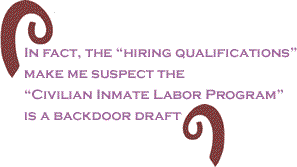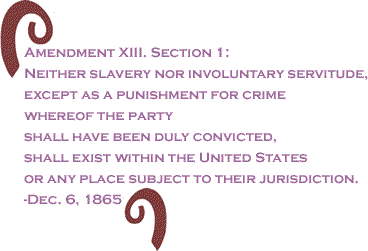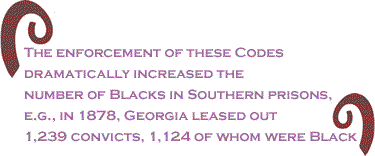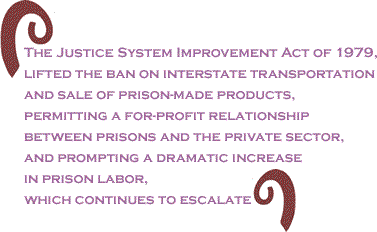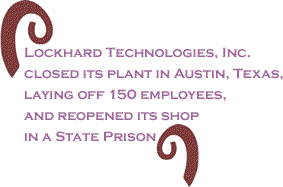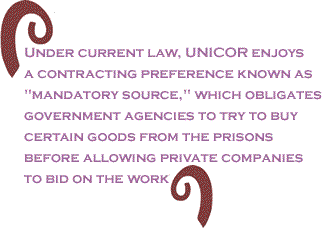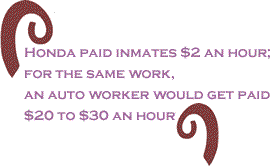
|
|||||||||||||||||||||
 |
|||||||||||||||||||||
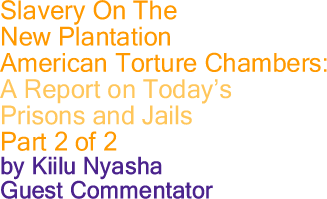 |
|
One of the newest forms of slave labor is the U.S. Army’s “Civilian Inmate Labor Program” to “benefit both the Army and corrections systems” by providing “a convenient source of labor at no direct cost to Army installations,” additional space to alleviate prison overcrowding, and cost-effective use of land and facilities otherwise not being utilized. “With a few exceptions,” this program
is currently limited to prisoners under the Federal Bureau of
Prisons (FBOP) which allows the Attorney General to provide the
services of federal prisoners to other federal agencies, defining
the types of services they can perform. The Program stipulates
that the “Army is not interested in, nor can afford, any
relationship with a corrections facility if that relationship
stipulates payment for civilian inmate labor. Installation civilian
inmate labor program operating costs must not exceed the cost
avoidance generated from using inmate labor.” In other words
the prison labor must be free
The three “exceptions” to exclusive
Federal contracting are as follows:
This Civilian Inmate Labor Program document includes in its countless specifications such caveats as “Inmates must not be referred to as employees.” A prisoner would not qualify if he/she is a “person in whom there is a significant public interest,” who has been a “significant management problem,” “a principal organized crime figure,” any “inmate convicted of a violent crime,” a sex offense, involvement with drugs within the last three years, an escape risk, “a threat to the general public.” Makes one wonder why such a prisoner isn’t just released or paroled. In fact, the “hiring qualifications” make me suspect the “Civilian Inmate Labor Program” is a backdoor draft, especially in lieu of the Bush Administration’s plan to increase troop levels in Iraq with a military already stretched to its limit. The 13th Amendment to the U.S. Constitution (it needed a lot of amending) retained the right to enslave within the confines of prison. Nearly 400 years of chattel slavery was secured and perpetuated by Amendment XIII. Section 1: Neither slavery nor involuntary servitude, except as a punishment for crime whereof the party shall have been duly convicted, shall exist within the United States or any place subject to their jurisdiction. -Dec. 6, 1865
Even before the so-called abolition of slavery, America’s history of prisoner labor had already begun in New York’s State Prison at Auburn soon after it opened in 1817. Auburn became the first prison that contracted with a private business to operate a factory within its walls. Later, in the post Civil War period, the “contract and lease” system proliferated, allowing private companies to employ prisoners and sell their products for profit. In Southern states, Slave Codes were rewritten as Black Codes, a series of laws criminalizing the law-abiding activities of Black people, such as standing around, “loitering,” or walking at night, “breaking curfew.” The enforcement of these Codes dramatically increased the number of Blacks in Southern prisons, e.g., in 1878, Georgia leased out 1,239 convicts, 1,124 of whom were Black. The lease system provided slave labor for plantation owners or private industries as well as revenue for the state, since incarcerated workers were entirely in the custody of the contractors who paid a set annual fee to the state (about $25,000). Entire prisons were leased out to private contractors who literally worked hundreds of prisoners to death. Prisons became the new plantations; Angola State Prison in Louisiana actually was a plantation. It still is except the slaves are now called convicts and the prison is known as “The Farm.” (A documentary of that title is available on DVD.) The loss of outside jobs and the inherent brutality and cruelty of the lease system sparked resistance which eventually brought about its demise. One of the most famous battles was the Coal Creek Rebellion of 1891. When the Tennessee coal, Iron and Railroad locked out their workers and replaced them with convicts, the miners stormed the prison and freed 400 captives; and when the company continued to contract prisoners, the miners burned the prison down. The Tennessee leasing system was disbanded shortly thereafter. But it remained in many states until the rise of resistance in the 1930s.
Strikes by prisoners and union workers together were organized by the then radical CIO and other labor unions. They pressured Congress to pass the 1935 Ashurst-Sumners Act making it illegal to transport prison-made goods across state lines. But under President Jimmy Carter, Congress granted exemptions to the Act by passing the Justice System Improvement Act of 1979, which produced the Prison Industries Enhancement program, or PIE, that eventually spread to all 50 states. This lifted the ban on interstate transportation and sale of prison-made products, permitting a for-profit relationship between prisons and the private sector, and prompting a dramatic increase in prison labor, which continues to escalate. As the leasing system phased out, a new, even more brutal exploitation emerged: the chain gang. An extremely dehumanizing cruelty that chained men, and later women, together in groups of five, it was originated to build extensive roads and highways. The first state to institute chain gangs was Alabama, followed by Arizona, Florida, Iowa, Indiana, Illinois, Wisconsin, Montana, and Oklahoma. Georgia’s chain-gang conditions were particularly brutal. Men were put out to work swinging 12 lb. sledge hammers for 16 hours a day, malnourished and shackled together, unable to move their legs a full stride. Wounds from metal shackles often became infected, leading to illness and death. Prisoners who could not keep up with the grueling pace were whipped or shut in a sweat box or tied to a hitching post, a stationary metal rail. Chained to the post with hands raised high over his head, the prisoner remained tethered in that position in the Alabama heat for many hours without water or bathroom breaks. (Human Rights Watch World Report 1998). Thanks to a lawsuit settled by the Southern Poverty Law Center, Alabama’s Department of Corrections agreed, in 1996, to stop chaining prisoners together. A few years later, the Center won a Court ruling that ended use of the hitching post as a violation of the 8thAmendment’s ban on “cruel and unusual punishment".
A report by Timothy Dodge in “Alabama Review” noted, When the convict-lease system was abolished in 1928, most of the white convicts, who had been leased to coal mines and lumber camps, were sent to the cotton mills and metal workshops at Kilby and Speigner prisons, whereas most of the black convicts ended up in chain gangs. In effect, the black chain gang was a continuation of racist slave labor. In response to the demands of World War II, the number of both free and captive road workers declined significantly. In 1941, there were 1,750 prisoners slaving in 28 active road camps for all types of construction and maintenance. The numbers bottomed out by war's end at 540 captives in seventeen camps. Although chain gangs were phased out in 1955, Alabama reinstituted chain gangs in 1995 followed by Arizona, Florida, Iowa, and Maine. Arizona’s first female chain gang was instituted in 1996. Complete with striped uniforms, the women of a Phoenix jail (to this day) spend four to six hours a day chained together in groups of 30, clearing roadsides of weeds. In the 1940s, California Governor Earl Warren conducted secret investigations into the State’s only prisons, San Quentin and Folsom. The depravity, squalor, sadism, and torture he found led the governor to initiate the building of Soledad Prison in 1951. Prisoners were put to work in educational and vocational programs that taught basic courses in English and math, and provided training in trades ranging from gardening to meat cutting. At wages of 7 to 25 cents an hour, California prisoners used their acquired skills to turn out institutional clothing and furniture, license plates and stickers, seed new crops, slaughter pigs, produce and sell dairy products to a nearby mental institution.
Within a decade this “model prison” at Soledad had become another torture chamber of filthy dungeons, literal “holes,” virulently racist guards, officially sanctioned brutality, torture, and murder. Though prison jobs are supposed to be voluntary, if prisoners refuse to work they’re often given longer sentences, denied privileges, or thrown into solitary confinement. Prisoners were brutalized and forced to work long hours under miserable conditions. In the 1960s, “Soledad Brother,” George Jackson, organized a work strike that turned into a riot after white strikebreakers tried to lynch one of the Black strikers. The Black Movement’s resistance, led by Jackson, W. L. Nolen, and Hugo “Yogi” Pinell, eventually brought Congressional oversight and overhaul of California’s prison system. (The Melancholy History of Soledad Prison, by Min S. Yee.). Yet, little has changed except for an incredible expansion that now has the state system bursting at the seams with 174,000 prisoners (The L.A. Times reported 12/23/06 a 1,000 prisoner increase in a matter of weeks!) crammed into 90 penitentiaries, small prisons and camps stretched across 900 miles of the fifth-largest economy in the world, as Ruth Gilmore’s new book, “Golden Gulag” reports. Since 1984, the state has erected 43 penal institutions, making it a global leader in prison construction. Most of the new prisons have been built in rural areas far from family and friends, and most captives are Black or Brown men, unemployed or working poor. Suicide and recidivism rates approach twice the national average, and the State spends as much or more on prisons as on higher education. In fact, Governor Schwarzenazi ‘s [sic] solution to prison overcrowding is to send prisoners out of state, and add 78,000 more beds, spending $11 billion more of your taxes on a failed prison system. For Fiscal Year 2005-2006, the California Department of Corrections and Rehabilitation (CDCR) was allocated a total of $7,398,743,000. (and "Rehabilitation” was added to the CDC by the new Governor, sans rehab.)
In 1985, U.S. Supreme Court Justice Warren Burger lauded China’s prison labor program: “1,000 inmates in one prison I visited comprised a complete factory unit producing hosiery and what we would call casual or sport shoes... Indeed it had been a factory and was taken over to make a prison.” Burger called for the conversion of prisons into factories, the repeal of laws limiting prison industry production and sales, and the active participation of business and organized labor. Heeding the judge’s call, California voters passed Prop 139 in 1990, establishing the Joint Venture Program allowing California businesses to cash in on prison labor. “ This is the new jobs program for California, so we can compete on a Third World basis with countries like Bangladesh,” observed Richard Holober with the California Federation of Labor. Businesses in Joint Venture must pay at least minimum wage (although the State takes back 80 percent of prisoners’ pay checks) and promise they’re not taking jobs away from people on the outside. But in reality. they have. For example, Lockhard Technologies, Inc. closed its plant in Austin, Texas, laying off 150 employees, and reopened its shop in a State Prison. (“Prison Labor on the Rise in US,” Whyte & Baker, 2000). In 1994, Oregon voters passed a constitutional amendment establishing a mandatory 40-hour work week for the State’s prisoners, resulting in the loss of thousands of civil service and private sector jobs. Outside construction workers lost jobs when prisoners were assigned to build more units, literally building their own cages. Currently, California’s Prison Industrial Authority (PIA) employs 5,900 captives and operates over 60 service, manufacturing, and agricultural industries at 22 prisons throughout the state. It produces over 1,400 goods and services including office furniture, clothing, food products, shoes, printing services, signs, binders, eye wear, gloves, license plates, cell equipment, and much more. Wages are $.30 to $.95 per hour before deductions, according to the PIA’s latest figures on its website. When I need new glasses, they have to be sent to Donovan State Prison, San Diego, where prisoners fill prescriptions for Medi-Cal patients. For the State’s highest wage, $1 hour, prisoners provide the “backbone of the state’s wild land fire fighting crews,” according to an unpublished CDC report. The State Department of Forestry saves more than $70 million annually using prison labor. California’s Department of Forestry has 198 Fire Crews comprised of CDC and CYA (California Youth Authority) minimum-security captives housed in 41 Conservation Camps throughout the state.
“Their primary function is to construct fire lines by hand in areas where heavy machinery cannot be used because of steep topography, rocky terrain, or areas that may be considered environmentally sensitive.” (i.e., the most dangerous fire lines). CYA juveniles are also working for TWA as ticket agents, assembling computer circuit boards, doing sheet metal work, photo copying, and packaging plastic eating utensils for fast-food restaurants. Now at least 37 states have similar programs wherein prisoners manufacture everything from blue jeans to auto parts, electronics and toys. Clothing made in Oregon and California is exported to other countries, competing successfully with apparel made in Asia and Latin America. The Federal Prison Industries (FPI), a nonprofit Justice Department subsidiary that does business as UNICOR, was created in 1935. and began supplying the Pentagon on a broad scale in the 1980s. In 1985, according to the Federal Bureau of Prisons, FPI had 71 factories enslaving 9,995 captives generating sales of $239.9 million. By 2003, there were 100 FPI factories working 20,274 slaves with sales totaling $666.8 million. Currently, FPI employs about 19,000 captives, slightly less than 20 percent of the federal prison population, in 106 prison factories around the country. Profits totaled nearly $40 million! In 2005, FPI sold more than $750,000,000 worth of goods to the federal government. Sales to the Army alone put UNICOR on the Army’s list of top 50 suppliers, ahead of well-known corporations like Dell Computer, according to Wayne Woolley, Newhouse News Service. Over the past three years, thousands of federal prisoners have been working overtime, filling Pentagon contracts for everything from radio components to body armor. Since the beginning of the war in Afghanistan in 2001, the Army's Communication and Electronics Command at Fort Monmouth, N.J., has shipped more than 200,000 radios to combat zones, most with at least some components manufactured by federal inmates working in 11 prison electronics factories around the country. Under current law, UNICOR enjoys a contracting preference known as "mandatory source," which obligates government agencies to try to buy certain goods from the prisons before allowing private companies to bid on the work. This same contracting restriction applies to state agencies. The demand for defense products from FPI became so great that “national exigency” provisions were invoked so the 20 percent limit on goods provided in each category could be exceeded. The rules were waived during the 1991 Persian Gulf War. Private manufacturers say they’ve been hurt by such practice, as they are unable to bid on various products.
According to the Left Business Observer, the federal prison industry produces 100% of all military helmets, ammunition belts, bullet-proof vests, ID tags, shirts, pants, tents, bags, and canteens. Along with war supplies, prison workers supply 98% of the entire market for equipment assembly services, 93% of paints and paintbrushes, 92% of stove assembly, 46% of body armor, 36% of home appliances, 30% of headphones/microphones/speakers, and 21% of office furniture, airplane parts, medical supplies, and much more. Prisoners are even raising seeing-eye dogs for blind people. By 2007, the overall sales figures and profits for federal and state prison industries had skyrocketed into the billions. Apparently, the military industrial complex and the prison industrial complex (PIC) have joined forces. This PIC is a network of public and private prisons, of military personnel, politicians, business contacts, prison guard unions, contractors, subcontractors and suppliers, all making big profits at the expense of poor people who comprise the overwhelming majority of captives. The fastest growing industry in the country, it has its own trade exhibitions, conventions, websites, and mail-order/Internet catalogs and direct advertising campaigns. Corporate stockholders who make money off prisoners’ labor, lobby for longer sentences in order to expand their workforce. Replacing the “contract and lease” system of the 19th Century, private companies that have contracted prison labor include Microsoft, Boeing, Honeywell, IBM, Revlon, Pierre Cardin, Compaq, Victoria Secret, and Nordstrom. In 1995, there were only five private prisons in the country, with a population of 2,000 inmates; now, there are at least 100, with some 62,000 inmates. That number is expected to hit 360,000 within a decade. The two largest private prison corporations in the US, Wackenhut and Corrections Corporation of America (CCA), are transnationals, managing prisons and detention centers in at least 13 states, Australia, Canada, South Africa, and the United Kingdom. A top performer on the New York Stock Exchange, CCA called California its “new frontier,” and boasts of investors such as Wal-Mart, Exxon, General Motors, Ford, Chevrolet,Texaco, Hewlett-Packard, Verizon, and UPS. Employers (Read: slave masters) don’t have to pay health or unemployment insurance, vacation time, sick leave or overtime. They can hire, fire or reassign inmates as they so desire, and can pay the workers as little as 21 cents an hour. The inmates cannot respond with a strike, file a grievance, or threaten to leave and get a better job. Mass roundups of immigrants and non-citizens, currently about half of all federal prisoners, and dragnets in low-income ‘hoods have increased the prison population to unprecedented levels. Andrea Hornbein points out in Profit Motive, “The majority of these arrests are for low level offenses or outstanding warrants, and impact the taxpayer far more than the offense. For example, a $300 robbery resulting in a 5 year sentence, at the Massachusetts average of $43,000 per year, will cost $215,000. That doesn’t even include law enforcement and court costs.”
Nearly 75% of all prisoners are drug war captives. A criminal record today practically forces an ex-con into illegal employment since they don’t qualify for legitimate jobs or subsidized housing. Minor parole violations, unaffordable bail, parole denials, longer mandatory sentencing and three strikes laws, slashing of welfare rolls, overburdened court systems, shortage of public defenders, massive closings of mental hospitals, and high unemployment (about 50% for Black men) all contribute to the high rates of incarceration and recidivism. Thus, the slave labor pool continues to expand. “In order to please shareholders, corporations must achieve growth. Empty cells do not generate profits.” (Hornbein) Unions have been virtually silent about the huge growth of prison labor in the U.S., reports Alan Whyte and Jamie Baker (“Prison Labor on the Rise in U.S., 2000). The Tennessee AFL-CIO supported privatization of the state’s prison system and struck a deal with CCA in 1997. For the most part, unions have bought into the prison system’s propaganda, blaming prisoners for job losses and pitting them against organized labor. In fact, two Republicans have competing bills in Congress: one would expand the PIC and give prisoners a raise from 21 cents to $1.15 an hour, the other would compel prison industry to compete with private enterprise, with support from the AFL-CIO. Honda paid inmates $2 an hour; for the same work, an auto worker would get paid $20 to $30 an hour. But in this instance, the United Auto Workers raised hell, pressuring Honda to cancel its prison labor contract. Among the most powerful unions today are the guards’ unions. The California Corrections Peace Officers Association (CCPOA) wields so much political power it practically decides who governs the state. Moreover, its members get the State’s biggest payouts, according to the L.A. Times. “More than 1600 officers’ earnings exceeded legislators’ 2007 salaries of $113,098.” Base pay for 6,000 guards earning $100,000 or more totaled $453 million, with overtime adding another $220 million to wages. One lieutenant guard earned more than any other state official, including the Governor, or $252,570. The Progressive Labor Party accuses the prison industry of being "an imitation of Nazi Germany with respect to forced slave labor and concentration camps." The National Correctional Industries Association (NCIA) is an international nonprofit professional association, whose mission is to promote excellence and credibility in correctional industries through professional development and innovative business solutions. NCIA's members include all 50 state correctional industry agencies, Federal Prison Industries, foreign correctional industry agencies, city and county jail industry programs, and private sector companies working in partnership with correctional industries. In summary, we must remember that the emancipation of Black people from chattel slavery resulted from prolonged guerrilla warfare between the slaves and the slave owners, led by the revolutionary General Harriet Tubman. More than 50,000 slaves fled from the South to the North and Canada, 50,000 acts of rebellion. As George Jackson noted in a KPFA interview with Karen Wald (Spring 1971), “I’m saying that it’s impossible, impossible, to concentration-camp resisters....We have to prove that this thing won’t work here. And the only way to prove it is resistance...and then that resistance has to be supported, of course, from the street....We can fight, but the results are...not conducive to proving our point...that this thing won’t work on us. From inside, we fight and we die....the point is -- in the new face of war -- to fight and win.” Click here to read Part 1. This article originally appeared in the San Francisco Bay View. To reach the Bay View, email [email protected]. Email Kiilu Nyasha, Black Panther veteran and revolutionary journalist, at [email protected]. |
|
| Home | |
| February 15,
2007 Issue 217 |
||||||||||||||
|
||||||||||||||
| Printer Friendly Version in resizeable plain text format | ||||||||||||||
 |
||||||||||||||
|
||||||||||||||
 |
||||||||||||||
 |
||||||||||||||
 |
||||||||||||||
| |
||||||||||||||
| |
||||||||||||||






















